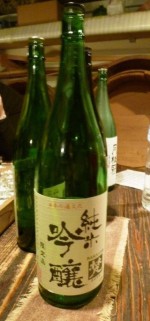Loading
Search
▼ Sake Tasting at Shimada Shoten
- Category:Gourmet

JAPAN TRAVEL
Hidden Cellar For The Ultimate Sake Experience
Do not judge a book by its cover; I was deceived by the ordinary looking Shimada Shoten when I first saw it at the corner of the street. It looks just like any other ordinary sake shop in Japan, but below the surface is a “hidden” cellar for sake-tasting that dates back from 1982. The passionate owner of Shimada Shoten has been to about 250 breweries in Japan and he stocks only the best sake in his cellar. Here, you can have the chance to try a wide variety of sake from all around Japan till your heart’s content.
As you enter, there is a great variety of sake on display. Let the shop know that you are interested in doing a tasting (sake no shi in), and you will be led to a hole in the floor that leads down through a narrow ladder, giving you a feeling as though you are going to a secret society meeting. The entrance to the cellar at the bottom is rather narrow and is only dimly lighted, so be very careful when you climb down. I felt like Alice in Wonderland coming out from the other side of the tunnel, finding myself with hundreds of sake bottles nicely arranged. Just beside the cellar is a separate space with three tables for sampling the product.
The sake here ranges from top-grade like Daiginjo (大吟醸) to some with distilled alcohol like Jozo (醸造酒). Shimada Shoten has a very simple system to its sake-tasting service: 60ml tasting glasses are placed on the table and it costs 210 yen for every fill, regardless of grade or type. Basically, the more the rice is polished, the better the quality of sake. So the quality and price depends on how much the rice is polished. The percentage of alcohol is also relevant to the quality of sake.
Daiginjo has a rice polishing ratio of below 50%, Ginjo is below 60% and Jozo or Junmai is below 70%. Jozo basically means sake that contains distilled alcohol. Daiginjo and Ginjo also have Jozo type and Junmai type (rice only).
Of course, you can ask the owner for recommendations depending of your preference. I started off with a Ginjo, which has somewhat of a crisp and fruity flavor to it. If you prefer a more mellow and rich sake, Junmai would probably be your favorite. One pleasant surprise was the Kyogekka (京月華), vintage sake (Koshu-古酒) that tastes very sweet and smooth.
Shimada Shoten also serves two kinds of shu-ko or a-te, food to accompany the sake. They have cream cheese made from Daiginjo (must try!), chunky miso from Wakayama, and umeboshi, all for 210 yen each.
Perfect combination of great sake with the tasty shukos! For those who are out for the ultimate sake experience, instead of drinking from the tasting glass, you can also savor your sake with an ochoko Japanese sake cup. There is a selection of ochoko on display to choose from, all unique in shapes and sizes. To settle your bill, you need to climb up the narrow ladder back up to the counter. The shop does not count the number of glasses you drink, so you need to remember to keep tab of the number yourself.
It is quite fun even if you are not a sake lover, to drink and compare various sake while enjoying the atmosphere in the “cave” with other guests. So, don’t miss the chance to drop by here when you are in town for a rendezvous with Shimada Shoten’s sake!
- March 23, 2016
- Comment (0)
- Trackback(0)




